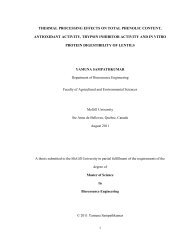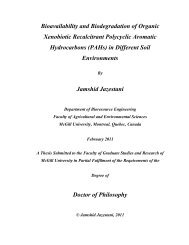Postharvest treatments to reduce chilling injury symptoms in stored ...
Postharvest treatments to reduce chilling injury symptoms in stored ...
Postharvest treatments to reduce chilling injury symptoms in stored ...
You also want an ePaper? Increase the reach of your titles
YUMPU automatically turns print PDFs into web optimized ePapers that Google loves.
v) As the fruit ripens the flesh becomes softer. At the peak of ripen<strong>in</strong>g the fruit<br />
firmness decreases and soften<strong>in</strong>g of the fruit is associated with an <strong>in</strong>creased<br />
solubility of cell wall pect<strong>in</strong>s (Roe and Bruemmer, 1981).<br />
vi) Certa<strong>in</strong> monoterpene hydrocarbons and lac<strong>to</strong>nes are responsible for mango<br />
flavor (Wilson et al., 1990).<br />
vii) At the early stage of growth polyphenolic content are high and decrease with<br />
the ripen<strong>in</strong>g and rema<strong>in</strong> fairly steady (Lakshm<strong>in</strong>arayana et al., 1970).<br />
viii) Dur<strong>in</strong>g ripen<strong>in</strong>g lipid content <strong>in</strong>creases along with <strong>in</strong>creases <strong>in</strong> glyceride and<br />
l<strong>in</strong>olenic acid (Bandyopadhyay and Gholap, 1973)<br />
2.6.1 Ripen<strong>in</strong>g of mangoes by us<strong>in</strong>g chemicals<br />
Mango fruits ripen unevenly on the tree and natural ripen<strong>in</strong>g can be very slow and<br />
unpredictable. Hence, <strong>to</strong> overcome these problems certa<strong>in</strong> chemicals are used <strong>to</strong> ripen the<br />
fruits artificially. Fruits were briefly exposed <strong>to</strong> ethylene or similar gases like acetylene <strong>to</strong><br />
<strong>in</strong>itiate the ripen<strong>in</strong>g process. Ethylene is known <strong>to</strong> be a plant hormone that triggers fruit<br />
ripen<strong>in</strong>g. It has been reported that if ethylene is applied exogenously it helps fruit<br />
ripen<strong>in</strong>g (Medlicott et al., 1988). Ethylene -treatment is usually given at the pack<strong>in</strong>g house<br />
or at the po<strong>in</strong>t of distribution.<br />
Ethephon is known as one of the most common ethylene-generat<strong>in</strong>g chemical and<br />
postharvest <strong>treatments</strong>. Ethephon accelerates ripen<strong>in</strong>g and improves the peel color of the<br />
mangoes (Lakshm<strong>in</strong>arayana et al., 1975). Use of chemicals promotes the ripen<strong>in</strong>g<br />
process and improves color development of the fruits. Aside from this, ethylene is an<br />
explosive gas and is very expensive. Certa<strong>in</strong> develop<strong>in</strong>g countries use calcium carbide as<br />
a fruit ripen<strong>in</strong>g agent. Acetylene gas is generated from calcium carbide, which <strong>in</strong>itiates<br />
the ripen<strong>in</strong>g process. This practice is commercially used <strong>in</strong> Brazil and Senegal (Medlicott,<br />
1986a). Acetylene is also an explosive gas and calcium carbide is more commonly used<br />
<strong>in</strong> weld<strong>in</strong>g applications. It is very <strong>to</strong>xic and has disadvantages compared <strong>to</strong> ethylene.<br />
Calcium carbide is considered as extremely hazardous sometime it conta<strong>in</strong>s traces of<br />
arsenic and phosphorus hydride, which is harmful for human consumption (Delpierre,<br />
1974). MJ -treatment <strong>reduce</strong>s the CI symp<strong>to</strong>ms of mangoes cv. Kent and enhances the<br />
sk<strong>in</strong> color development of the fruit (González-Aguilar et al., 2001).<br />
23









